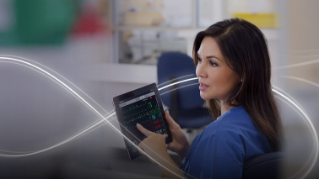John Mendonca, National Account Manager Digital Health Solutions
John Mendonca, our national account manager for digital heath solutions, talks about the exciting future of connectivity and how a consultation process helps deliver the best results for patients and end users alike.

1: Tell us about why you initially joined Mindray?
I spent 15 years as a business development specialist for another large medical device supplier and in that time I started to come up against more and more impressive products from Mindray. Whether at show and tell events or on social media I could see the speed of innovation, and it made me a bit envious!
I was watching these connected solutions get more advanced and I wanted to be a part of it. I could see the future of the industry in the complete connected healthcare system, and I could tell Mindray thought the same thing.
2: How has the industry changed since you started?
Around six years ago I started to notice the shift from connectivity being an add-on extra to simply a requirement in big tenders. Now connectivity is an expectation, and our customers don’t just expect us to provide it, they want to know how we can customise the system to suit them.
Digital tools are obviously more widely accepted than ever, after COVID, so I’ve seen customers more accustomed to virtual working. This could help encourage a larger shift over to more mobile monitoring through healthcare applications, like the introduction of Mobile Viewer and CMS Viewer we’ve seen recently at one of our connected sites.
3: What does your role entail?
The official title is National Account Manager for Digital Health Solutions, but I would describe my job as a ‘solutions consultant’. In order to match the customer’s requirements with suitable systems, I first have to understand their needs and pain points, so that’s a very consultative process. I’ll also work with a customer throughout their connectivity project, not just the initial sales stage, meaning I have to be ready to provide project management support as well.
4: What is your proudest moment at Mindray so far?
Seeing the acceleration of connected projects within the business makes me proud, but personally my proudest moment was helping Mindray win a connected vital signs contract at a large London Trust. I’ve worked in the low-acuity space for a long time and so being able to showcase this futuristic fully connected vital signs system was a special moment. To know that the systems I’ve installed have contributed to better patient care makes me feel proud to work in this industry.
5: What does the future of connectivity look like for Mindray and the MedTech industry?
Mindray are increasingly partnering with EPR and information system vendors to create customised systems that can gather data in new ways, so I think we will see devices becoming further enhanced and upgraded by utilising all that new information. The industry as a whole is recognising that software vendors and device manufacturers can work together to create better systems, and Mindray is helping drive that change in perception.
We already have a lot of the tools I think will be integral to connectivity in the future – but the scale of interoperability will likely be the next big change. As more and more third-party devices become integrated into a connected system, the pool of clinical and technical data becomes larger and more useful. This push for more data will drive greater connectivity between different devices, which will eventually all be integrated into one GUI (graphical user interface).
6: What have you gained from working at Mindray?
Before Mindray I mainly worked in the low-acuity space and so this new position has given me much greater exposure to the different care settings within the NHS, and the challenges those areas face. Working out how connectivity can support clinicians in different departments or across whole hospitals has been an exciting challenge.
7: What key principals have guided you in your career and been key to your success?
I always keep in mind the end user and the patients. For the patients I think it’s important to just think about the system from their point of view; that’s who the system is there for. The next patient going through that system could be a friend or family member, but no matter who they are ultimately it needs to work for them and give them as much support as they need. As for the end users, we throw all of this technology at them in a high-pressure environment and they do a phenomenal job managing it, but they want simplicity. My job is help provide a system that brings the complex elements together and makes their lives easier.
8: What do you enjoy doing outside work?
I’ve got a big family which keeps me busy, with two girls aged 17 and five, and a 14-year-old boy. My son is into his football so on weekends I like to watch him play. Other than that, I’m lucky enough to live close to the Forest of Bowland so when I get time, I love going up there on my bike.
.jpg)
